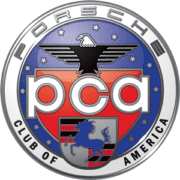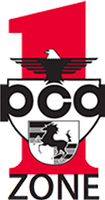NNJR PORSCHE CAR CONTROL CLINIC, APRIL 22, 2012
So what did you decide to do on a rainy, cold Sunday, April 22? About 60 plus of us went and played with our Porsches in the rain at Met Life Stadium Meadowlands Parking Lot J. We were assigned instructors and led around four different driving stations, including a slalom course, a braking exercise, and two skid pads, clockwise and counterclockwise. The wet pavement helped make the event more enjoyable and educational.
Do any of us really know how fast we can stop our cars in an emergency situation? We learned more about that in the braking exercise. After starting up, shifting to second, we maneuvered a sharp right hand turn, and then floored it until we thought we needed to brake hard and try to stop just in front of the designated stop cones. Each successive run through this braking exercise (we must have had 6 or 7 passes), we increased our speed and control on the right turn, and got closer to the stop cones. Most of us stopped way short the first time, got closer in runs 2 and 3, and plowed through the cones on another run, before really figuring out when to brake and successfully stop before the cones. Porsche brakes are indeed amazing.
The slalom course taught us about control and cornering, driving smooth, and looking ahead. Bill Knox, first time CCC driver, described the slalom as a different kind of challenge, with much more emphasis on precise steering than speed. Bill’s instructor, Mike Raff urged Bill to move smoothly, without jerkiness. “It took almost all my turns to come even close to acceptable.” Bill was grateful that for him, the slalom came last after the braking and skid pad drills, “because all of the skills encouraged by the earlier drills were needed for the slalom.”
The most popular event is the skid pad. And everyone got to drive two of them. There is a big time learning exercise here – how to control the turn with the gas pedal, while the steering wheel is fixed. You start out driving outside a large circle of cones, (about 50-60 feet in radius?), trying to maintain that arc without turning the steering wheel, by using the gas pedal to speed up or slow down to maintain the turn. Sounds simple, right? Well, what a hoot – so many of us did partial, full and double spins, trying to learn the technique, to maintain a slight skid turn. We especially want to thank Brian Hernsdorf for that very entertaining double spin move on the clockwise skid pad in the afternoon. Everyone cheered his spins. Fortunately, Bill Gilbert laid out the courses carefully, (as he has done so well for so many years,) so we did not crash into any light poles, curbs, other cars or people.
A lot of learning and driving experience was gained on Sunday, that we can translate to safer street driving, as well as Autocross and Driver Ed events coming up soon.
First time CCC driver, Steve Barat, wrote “that it’s no surprise that the CCC is one of the most popular events offered. The conditions of the exercises in the clinic allow for the driver to experience how the vehicle they are driving behaves at the limits of adhesion when cornering, steering and breaking – but under safe, controlled conditions. The afternoon rain was really a plus for the clinic this year – literally turning the entire lot into a skid plate. As someone once said, success comes from good judgment, good judgment comes from experience, and experience comes from bad judgment. There is no better way to get experience as to how any particular vehicle will behave under certain circumstances than under the controlled conditions of such a clinic – and with an instructor to coach you along (or pull the e-brake on you while trying throttle-steer on the skid plate!). Simply put, the skid pad is a better place to feel what it is like for the car to push and perhaps even spin out – and learn how to recover – than an exit ramp during rush hour traffic. I for one was surprised to find where the limit of adhesion was in the wet with my car (actually higher than I would have initially thought). And needless to say, the braking exercise is a must have for anyone who gets behind the wheel. In fact, I would be of the opinion that such a clinic or course should be mandated to obtain a driver’s license, period! I mean really, who cares if you can parallel park if you haven’t a clue what to do if you aquaplane, and as a consequence panic?”
John Oskwarek, also a first time CCC driver, said that the CCC is a great way to safely learn the limits of your car and to hone your driving skills. On the one hand it is a humbling event. For example, it is not as easy as you think to steer with your right foot, or to stop a few inches away from the cones (braking exercise), especially on a wet road. On the other hand, it is a great confidence booster; with proper instruction and practice, you can be a much better driver, both on the track and on the road. John’s conclusions after the CCC are that Porsche 911s are GREAT cars: “I was reluctant to buy a 911 because I thought you had to be a driving expert to control the car at speed, that the rear end was balanced on the tip of a needle. Not so. Even with SC and TC turned off and on a wet road, they are predictable and manageable. A thrill to drive near the limit!“ John also learned that your control inputs will be smoother and more comfortable the further down the road you look. And on tight corners (slalom and braking exercise) more speed can be had by being patient at corner entry – Slow-in, Fast-out.
• Many thanks from all of us drivers to Tom Iervolino, the chief organizer of the CCC, and Bill Gilbert the CCC Architect who designed and laid out the courses, early Sunday morning. And they had a large cast of volunteers who arrived at 7am to help setup and organize the event (eg Marlys and Dennis Thovson, Akemi and Murray Kane, Ed Pepe, Jim Moore, Kelion Kasler, …and many others whose names I do not have).
Even though the Meadowlands unceremoniously changed our assigned lot from E to J early Sunday morning, Tom and Bill and team quickly adjusted and modified the layout to the new lot. Sounds simple, right? Well the parking lots are not symmetric, and the location of the light poles seriously affects the layout of the courses.
And we must have had over 30 volunteer instructors! We had morning and afternoon run groups, so there were enough instructors to have one-on-one coaching for all of us. We felt bad that the instructors did not get to drive (like at the DE events). But what a treat for us drivers to have such dedicated volunteer instructors. Thank you!
My instructor, Doug Holcomb, was especially patient and helpful. Doug was able to make simple adjustments to my driving technique (like looking further ahead) to dramatically improve my driving skills on the skid pads, braking and slalom courses.
Bill Knox wrote about his instructor, Mike Raff, that “he had the master teacher’s skills of making me feel that I might be up to the challenge, while prioritizing the most critical improvements I needed to focus on. Top of the list were keeping my hands in the right position and looking well ahead of where I was to where I wanted to be. And aside from Mike’s steady reassurances (he didn’t seem even worried, let alone terrified), there was this amazing feeling of heart-pounding happiness coming from somewhere as I floored the throttle, braked, turned harder than I had ever turned a steering wheel in my life, floored the throttle again, and then tried to smoothly shove the brake pedal through the floor as we approached the four-cone wall.”
The CCC is a great experience for new Porsche drivers, before they attend an Autocross or Driver Ed/Track event. But it is also good as well for anyone looking to learn more about driving their car in an instructed, controlled environment. The CCC is only held once a year, with limited sign ups, so look for it next spring.


